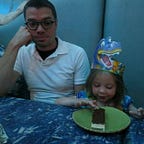Trapped in a -Scape
The prefix “scape-” comes from an archaic standalone word (scape): an old slang, short for “escape.” Its most common usage these days is in “scapegoat,” a word tied to a ritual othering — a way to banish things and people thought to be harmful to a group.
As a suffix, “-scape” derives from another gloomy usage: the 1796 neologism: prisonscape.
There’s a growing reliance on this suffix to explain how we talk/think about the places around us. But like its original meaning, the word has become a sort-of prison, constraining our imaginations and the way we understand the world.
This may seem a bit pedantic — maybe farfetched? — but go with me here for a minute.
Usually referring to a viewed scene, -scapes are part of what I call “a process of selection.” We pick and choose what we want people to picture. We are master assemblers — pigeonholing place into categories:
A mountain becomes a landscape when we add its foothills and the valley in front of it. A mountain turns into a skyscape when we want our listeners to chiefly think about the stars spreading above it.
But like most things with language, this is a “narrowing” — forcing an audience to value only a specific part of a scene.
If you were paying attention in Seventh-Grade English (and you’d be forgiven if you weren’t. Because, I mean: Pokémon), you’ll remember this is called “metonymy:” letting a small thing stand in for the whole.
By conjuring a landscape, we prioritize some elements at the expense of others. When we consider something someone has called a “landscape,” we reflect on the sublime beauty of nature. This causes a “forgetting.” These “empty” spaces can’t “see” the industrial pollutants wafting from a cityscape or the indigenous people who live(d) in their own -scape, somewhere outside the frame.
Metonymy is cunning. It works best when the stand-in helps us fixate on something. It simplifies the world. It is the best trick language has to trap us in certain imaginary places. We don’t realize what’s made invisible by it.
Think of all the other -scapes out there. In addition to land-, sky- and mountain-, there are soundscapes, snowscapes, mediascapes, xeroscapes and seascapes. For poets, photographers and journalists, they are helpful words to narrow the scope of a “story” — to help audiences “fit” into a place made to feel less complicated.
But here are a few implications (small to big) of those stories:
- Such a thing as a xeroscape keeps us focused on our own lawns rather than helping us question why we even have lawns in the first place.
- Seeing a landscape not only tricks us into believing nothing “human” is there, but it makes us forget how other peoples around the world view their surroundings. In many island cultures, for example, the sea orients history, time and culture. To suggest that the land is the most important thing denies the role of rivers and oceans and, ultimately, the legitimacy of alternative orientations.
- We are an (sorry: $20-word approaching) oculocentric culture. And defaulting to viewed scenes counteracts gains in disability rights. “I see therefore I am” ignores both the true nature of experience and those who don’t see at all. What drives thinking is actually multisensorial.
This is not a diatribe aiming to police language; I’m not advocating we get rid of any -scape. But like all linguistic narrowings, being more aware of how and why we describe a place expands how we experience it.
We frame the world in one way (with cameras as much as with our words and ideologies) and often forget that there are more ways to consider it.
By rethinking our use of -scapes, we force ourselves to pivot into the experiences of others (whether those in distant geographies or those who have differing dominant senses).
Focusing on the product (a -scape) misses the process for how artists — and the rest of us — assemble.
The arts — particularly painting and photography — consider -scapes as aesthetic genres. The works of J.M.W. Turner and Ansel Adams are resplendent; but how/what we think about a place doesn’t need to be considered solely by what’s in a frame, hanging on a wall.
Approaching one or two scenes (whether land- or sea-…or land AND sea) make others invisible. Landscapes ignore cityscapes; cityscapes ignore mountainscapes; oceanscapes ignore riverscapes. They all ignore soundscapes which, in turn, ignore tastescapes.
Focusing on the product misses the process for how artists (and the rest of us) construct that scene.
To truly process and account for the many ways to be in a place, I like this great poem from Ben Lerner’s 2006 collection Angle of Yaw:
“A STUDY OF A CHILD [ERASED], a study of erasure [Child],
the swiftness of pencils repeating a theme until it achieves the illusion of
enterable space. Rake me, she said, with a moral light, but the luster of
her ostrich-feather fan had dimmed her eyes. For the purpose of study,
we have removed those figures attributed to disciples, yielding a string of
visual commas and the inscription Turn away. We work with a found
vocabulary, working backwards from the detail to the richly textured
blindness of Parmigianino’s gaze. Anyway, as a child, I was thrown from
my Powell Peralta, and when I came to, my left-brain had been erased.
No street, no land, no sky — just scape.”
Thinking about how we create our own “position” forces attention to what those positions erase. It helps us understand how biases form and contribute to the process of what we assemblers are doing.
Perhaps we can move beyond envisioning individual -scapes and be attuned, more complexly, to “just scape.”
